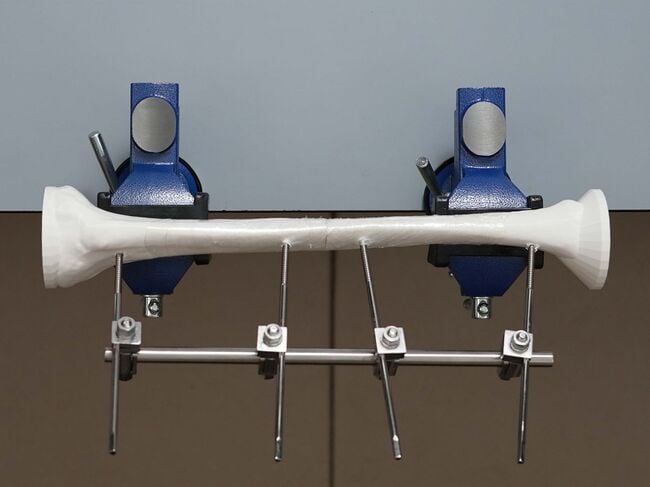
This module allows medical officers and surgeons who are not orthopedic specialists to become confident and competent in irrigation and debridement, powered and manual drilling, positioning and correctly inserting Schanz screws, and constructing the uniplanar external fixator frame as part of external fixation procedures for open tibial shaft fractures performed in regions without specialist coverage. To maximize patient safety, this module teaches learners to use a powered drill to insert self-drilling Schanz screws through the near cortex and then manually advance Schanz screws into the far cortex to avoid plunging.
A pair of learners is assigned to a station. While one learner conducts the simulation-based skills training, the other learner observes and fills out the Training Logbook. The learner roles are then switched.
Table 1. Materials and Equipment
| # | Item | Quantity | Reference Image | Function | Reusable | Comments |
|---|---|---|---|---|---|---|
| 1 | Clipboard | 1 per station | 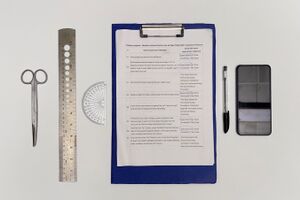 |
Used by learner to fill out Training Logbook for verification of technical competence | Yes | Locally available |
| 2 | Training Logbook | 1 per learner |  |
Used by learner to verify technical competence of the simulation-based skills training | No | Can be downloaded and printed locally |
| 3 | Self-Assessment Framework | 1 per station |  |
Used by learner to verify technical competence of the simulation-based skills training | Yes | Should be printed in colour |
| 4 | Pen | 1 per station |  |
Used to fill out the Training Logbook for learner verification of technical competence | Yes | Locally available |
| 5 | Eye Protection | 1 per learner | 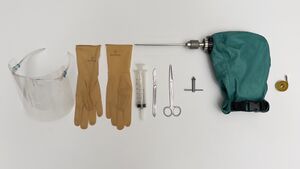 |
Used to protect the eyes of both learners at each station during simulation-based skills training | Yes | Locally available |
| 6 | Gloves | (2 pairs for 2 learners training at a station) |  |
Worn by both learners at each station during the simulation-based skills training | No | Locally available |
| 7 | 3D Printed Adult Male Tibial Bone Model #1 | 1 per learner | 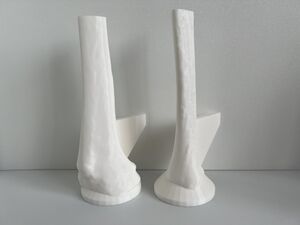 |
This open-source, 3D printed bone model can be locally reproduced on affordable, desktop 3D printers available worldwide and has excellent visual, tactile, and acoustic fidelity to allow learners (who have no prior experience with drilling into bone) teach themselves the skills to prevent plunging through the far cortex. | To experience the proper tactile feel when drilling into bicortical bone, every learner should perform at least one simulation-based procedure with 4 new, unused Schanz Screws and a new, unused Tibial Shaft Transverse Fracture Simulator. | Click here to find local 3D print on demand services |
| 8 | 3D Printed Adult Male Tibial Bone Model #2 | 1 per learner |  |
This open-source, 3D printed bone model can be locally reproduced on affordable, desktop 3D printers available worldwide and has excellent visual, tactile, and acoustic fidelity to allow learners (who have no prior experience with drilling into bone) teach themselves the skills to prevent plunging through the far cortex. | To experience the proper tactile feel when drilling into bicortical bone, every learner should perform at least one simulation-based procedure with 4 new, unused Schanz Screws and a new, unused Tibial Shaft Transverse Fracture Simulator. | Click here to find local 3D print on demand services |
| 9 | Cellophane | 1 roll per workshop | 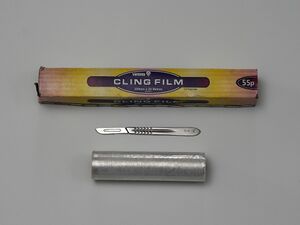 |
Wrapped around the slightly distracted 3D printed proximal and distal fracture fragments to simulate the soft tissue envelope and permit visual inspection for targeted self-assessment by the learner | No | Locally available |
| 10A | Vise Clamps; or 10B | 1 pair per station | 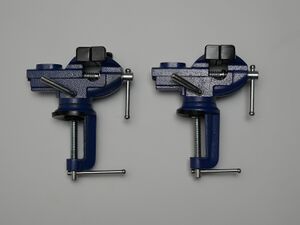 |
Secures the Tibial Shaft Transverse Fracture Simulator for safe simulation-based training; positioned so the fracture ends are distracted by 2.0 - 3.0 mm but are otherwise properly aligned to simulate a fracture with restored angulation, and rotation; and to simulate a patient in the supine position | Yes | You could purchase these vise clamps on Amazon, Jumia or Taobao. If not locally available, use items 10B.1-10B.4 |
| 10B.1 | Wood Board | 1 per pair of learners | 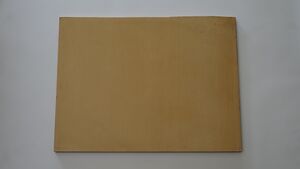 |
Lower-cost alternative to vise clamps for securing the Tibial Shaft Transverse Fracture Simulator for safe simulation-based training | No | Locally available |
| 10B.2 | Drill Bit | 1-2 per workshop | 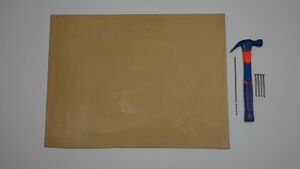 |
Used for the lower-cost alternative to vise clamps to secure the Tibial Shaft Transverse Fracture Simulator for safe simulation-based training | No | Locally available |
| 10B.3 | Hammer | 1 per workshop |  |
Used for the lower-cost alternative to vise clamps to secure the Tibial Shaft Transverse Fracture Simulator for safe simulation-based training | Yes | Locally available |
| 10B.4 | Nails | 4 per Tibial Shaft Fracture Simulator |  |
Used for the lower-cost alternative to vise clamps to secure the Tibial Shaft Transverse Fracture Simulator for safe simulation-based training | No | Locally available |
| 11 | Syringe, 50 mL | 1 per station | 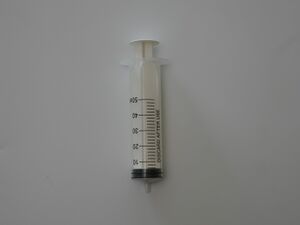 |
Used for irrigation of open wounds | Yes | Locally available |
| 12 | Bone Reduction Forceps | 1 per station | 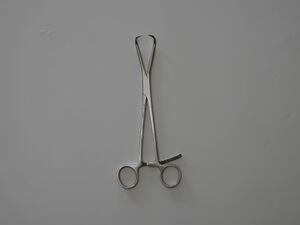 |
Used to manually reduce the fracture, compress the fragments together, and restore alignment | Yes | Can be loaned by a local facility that performs orthopedic surgical procedures |
| 13 | Bone Holding Forceps, Medium Size | 1 per station | 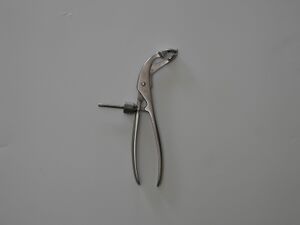 |
Used to maintain reduction | Yes | Can be loaned by a local facility that performs orthopedic surgical procedures |
| 14 | Scalpel Blade and Handle | 1 per station | 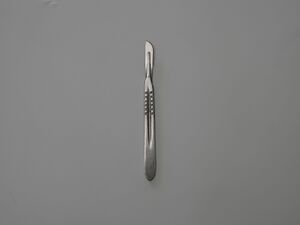 |
Used to make a stab incision in the soft tissue at the insertion site for each Schanz Screw; and to extend the wound to adequately expose the open fracture for direct visualization of the fracture (if required) | Yes | Can be loaned by a local facility that performs orthopedic surgical procedures |
| 15 | Sharps Container | 1 per workshop | Not shown | Used to store the scalpel blades for safe simulation-based training | Yes | Locally obtained. |
| 16 | Dissecting Scissors | 1 per station | 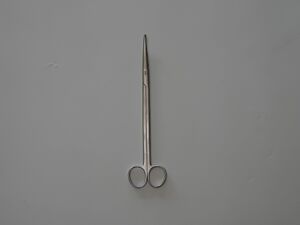 |
Used to dissect through the soft tissue to expose the bone at the insertion site for each Schanz Screw | Yes | Can be loaned by a local facility that performs orthopedic surgical procedures |
| 17 | Any powered surgical drill that is compatible with 4.5 or 5.0 mm diameter self-drilling Schanz screws | 1 per station | 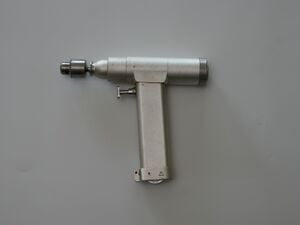 |
Drives Schanz Screw into fracture fragment, also referred to as "power drive" | Yes |
|
| 18 | Chuck Key for Surgical Drill | 1 per station | 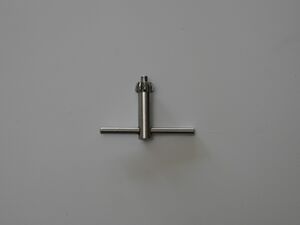 |
Used to tighten or loosen the drill over the Schanz screw | Yes | Can be loaned by a local facility that performs orthopedic surgical procedures |
| 19 | Self-Drilling Schanz Screws, 5.0 mm x 200 mm x 30 mm | 4 per learner | 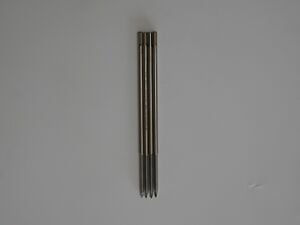 |
Inserted into fracture fragments, also referred to as "pins" or "half-pins" |
|
Ask your local orthopedic surgeon to obtain through their local orthopedic surgical hardware supplier |
| 20 | Drill Sleeve for 5.0 mm Schanz Screws | 1 per station | 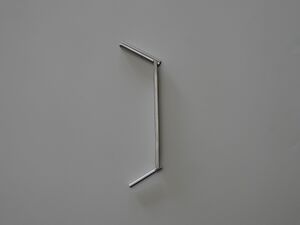 |
Used to protect the soft tissue when drilling the far pins | Yes | Can be loaned by a local facility that performs orthopedic surgical procedures |
| 21 | Universal Chuck with T-Handle | 1 per station | 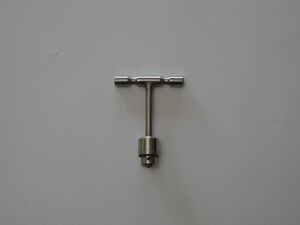 |
Allows for manual advancement of the Schanz Screw to the desired depth | Yes | Can be loaned by a local facility that performs orthopedic surgical procedures |
| 22 | Chuck Key for Universal Chuck with T-Handle | 1 per station | 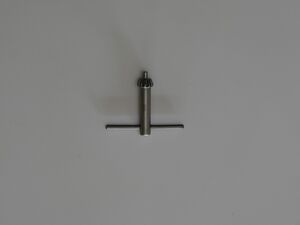 |
Used to tighten or loosen the Universal Chuck with T-Handle over the Schanz screw | Yes | Can be loaned by a local facility that performs orthopedic surgical procedures |
| 23 | Universal Clamp (Single Pin) | 4 per station | 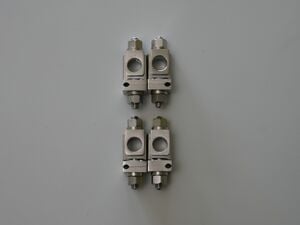 |
Combines pin-to-rod | Yes | Can be loaned by a local facility that performs orthopedic surgical procedures |
| 24 | Rod, 11 mm diameter x 300 mm length | 1 per station | 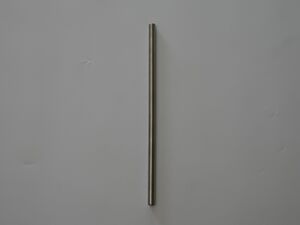 |
Links pins with clamps, metal rod is cheaper but a carbon fiber rod is radiolucent which permits better visualization of the fracture on X-ray | Yes | Can be loaned by a local facility that performs orthopedic surgical procedures |
| 25 | 11 mm Spanner with T-Handle | 1 per station | 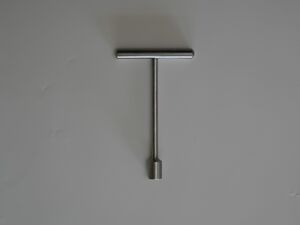 |
Assists in final tightening of clamps | Yes | Can be loaned by a local facility that performs orthopedic surgical procedures |
| 26 | Ruler, 30 cm | 1 per station |  |
Used by learner to objectively confirm proper fracture alignment of the Tibial Shaft Transverse Fracture Simulator for the Self-Assessment Framework | Yes | Locally available |
| 27 | Protractor | 1 per station |  |
Used by learner to measure the drill trajectory angles of the Schanz Screws for the Self-Assessment Framework | Yes | Locally available |
| 28 | Cellphone | 1 per learner |  |
Used by learner to take the photos of the Training Logbook and Tibial Shaft Transverse Fracture Simulator for the Self-Assessment Framework to record technical competence | Not applicable | Supplied by each learner |
Acknowledgements[edit | edit source]
This work is funded by a grant from the Intuitive Foundation. Any research, findings, conclusions, or recommendations expressed in this work are those of the author(s), and not of the Intuitive Foundation.
